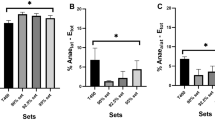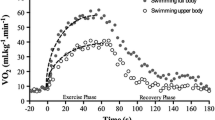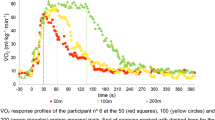Abstract
The energy cost per unit of distance (C s, kilojoules per metre) of the front-crawl, back, breast and butterfly strokes was assessed in 20 elite swimmers. At sub-maximal speeds (v), C s was measured dividing steady-state oxygen consumption (V˙O2) by the speed (v, metres per second). At supra-maximal v, C s was calculated by dividing the total metabolic energy (E, kilojoules) spent in covering 45.7, 91.4 and 182.9 m by the distance. E was obtained as: E = E an+V˙O2max t p−V˙O2max(1−e−( t p/)), where E an was the amount of energy (kilojoules) derived from anaerobic sources, V˙O2max litres per second was the maximal oxygen uptake, α (=20.9 kJ · l O2 −1) was the energy equivalent of O2, τ (24 s) was the time constant assumed for the attainment of V˙O2max at muscle level at the onset of exercise, and t p (seconds) was the performance time. The lactic acid component was assumed to increase exponentially with t p to an asymptotic value of 0.418 kJ · kg−1 of body mass for t p ≥ 120 s. The lactic acid component of E an was obtained from the net increase of lactate concentration after exercise (Δ[La]b) assuming that, when Δ[La]b = 1 mmol · l−1 the net amount of metabolic energy released by lactate formation was 0.069 kJ · kg−1. Over the entire range of v, front crawl was the least costly stroke. For example at 1 m · s−1, C s amounted, on average, to 0.70, 0.84, 0.82 and 0.124 kJ · m−1 in front crawl, backstroke, butterfly and breaststroke, respectively; at 1.5 m · s−1, C s was 1.23, 1.47, 1.55 and 1.87 kJ · m−1 in the four strokes, respectively. The C s was a continuous function of the speed in all of the four strokes. It increased exponentially in crawl and backstroke, whereas in butterfly C s attained a minimum at the two lowest v to increase exponentially at higher v. The C s in breaststroke was a linear function of the v, probably because of the considerable amount of energy spent in this stroke for accelerating the body during the pushing phase so as to compensate for the loss of v occurring in the non-propulsive phase.
Similar content being viewed by others
Author information
Authors and Affiliations
Additional information
Accepted: 14 April 1998
Rights and permissions
About this article
Cite this article
Capelli, C., Pendergast, D. & Termin, B. Energetics of swimming at maximal speeds in humans. Eur J Appl Physiol 78, 385–393 (1998). https://doi.org/10.1007/s004210050435
Issue Date:
DOI: https://doi.org/10.1007/s004210050435




